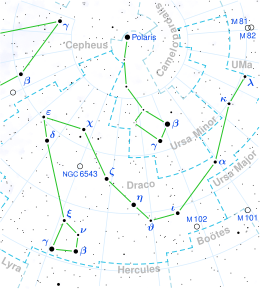64 Draconis
| Observation data Epoch J2000 Equinox J2000 | |
|---|---|
| Constellation | Draco |
| Right ascension | 20h 01m 28.65587s[1] |
| Declination | +64° 49′ 15.5038″[1] |
| Apparent magnitude (V) | 5.27[2] |
| Characteristics | |
| Evolutionary stage | red giant |
| Spectral type | M1 III[3] |
| B−V color index | 1.598±0.006[4] |
| Astrometry | |
| Radial velocity (Rv) | −36.12±0.13[4] km/s |
| Proper motion (μ) | RA: −24.818[1] mas/yr Dec.: +33.623[1] mas/yr |
| Parallax (π) | 7.2102 ± 0.1296 mas[1] |
| Distance | 452 ± 8 ly (139 ± 2 pc) |
| Absolute magnitude (MV) | −1.05[4] |
| Details | |
| Radius | 65[1] R☉ |
| Luminosity | 926[1] L☉ |
| Temperature | 3,952[1] K |
| Other designations | |
| Database references | |
| SIMBAD | data |
64 Draconis is a single[6] star in the northern circumpolar constellation of Draco, located 452 light years away.[1] It has the Bayer designation of e Draconis; 64 Draconis is the Flamsteed designation. The object is visible to the naked eye as a dim, red-hued star with an apparent visual magnitude of 5.27.[2] It is moving closer to the Earth with a heliocentric radial velocity of −36 km/s, and it is predicted to come as close as 204 ly in around 4.3 million years.[4]
This is an evolved red giant star with a stellar classification of M1 III,[3] currently on the asymptotic giant branch.[7] It has expanded to about 65 times the Sun's radius and is radiating 926 times the Sun's luminosity from its photosphere at an effective temperature of 3952 K. 64 Draconis forms a faint naked-eye pair with 65 Draconis 12′ away. The latter is a suspected variable with a brightness range in the Hipparcos photometric filter of 5.29 to 5.33.[8]
In Chinese astronomy, it belongs to the 天廚 (Tiān Chú) (Celestial Kitchen) asterism.[citation needed]
References[edit]
- ^ a b c d e f g h i Brown, A. G. A.; et al. (Gaia collaboration) (August 2018). "Gaia Data Release 2: Summary of the contents and survey properties". Astronomy & Astrophysics. 616. A1. arXiv:1804.09365. Bibcode:2018A&A...616A...1G. doi:10.1051/0004-6361/201833051. Gaia DR2 record for this source at VizieR.
- ^ a b Ducati, J. R. (2002). "VizieR On-line Data Catalog: Catalogue of Stellar Photometry in Johnson's 11-color system". CDS/ADC Collection of Electronic Catalogues. 2237. Bibcode:2002yCat.2237....0D.
- ^ a b Keenan, Philip C.; McNeil, Raymond C. (1989). "The Perkins catalog of revised MK types for the cooler stars". Astrophysical Journal Supplement Series. 71: 245. Bibcode:1989ApJS...71..245K. doi:10.1086/191373.
- ^ a b c d Anderson, E.; Francis, Ch. (2012). "XHIP: An extended hipparcos compilation". Astronomy Letters. 38 (5): 331. arXiv:1108.4971. Bibcode:2012AstL...38..331A. doi:10.1134/S1063773712050015. S2CID 119257644.
- ^ "HD 40409". SIMBAD. Centre de données astronomiques de Strasbourg. Retrieved 2018-07-16.
- ^ Eggleton, P. P.; Tokovinin, A. A. (2008). "A catalogue of multiplicity among bright stellar systems". Monthly Notices of the Royal Astronomical Society. 389 (2): 869. arXiv:0806.2878. Bibcode:2008MNRAS.389..869E. doi:10.1111/j.1365-2966.2008.13596.x. S2CID 14878976.
- ^ Eggen, Olin J. (1992). "Asymptotic giant branch stars near the sun". The Astronomical Journal. 104: 275. Bibcode:1992AJ....104..275E. doi:10.1086/116239.
- ^ Samus, N. N.; Durlevich, O. V.; et al. (2009). "VizieR Online Data Catalog: General Catalogue of Variable Stars (Samus+ 2007-2013)". VizieR On-line Data Catalog. 1. Bibcode:2009yCat....102025S.

